|

Introduction
The Predator range of monitors has been gaining
momentum in the display market for about 18 months now, as Acer continue to
invest in the latest technologies and try to offer buyers something interesting
and different. They were first to market back in Feb 2015 with a 144Hz high
refresh rate IPS-type panel in the form of the very popular
XB270HU. They were also first to market with an overclocked 100Hz compatible
34" IPS 3440 x 1440 display, in the form of the
X34.
We've reviewed a fair few different models from the Predator range now, in
different sizes and with different panel technologies, specs and features. We
now have with us the brand new Z271 which offers something a little different
yet again, and is another first for the market.
The Z271 is a 27" sized screen featuring a curved
VA panel and 1920 x 1080 resolution. Interestingly this is the first high
refresh rate VA panel available from the panel manufacturer Samsung, offering a
144Hz native refresh rate. It's combined with NVIDIA G-sync and a range of
extras and features which we've become accustomed to from the Predator range. We
should say up front that for some reason ULMB is not available on this model,
despite the G-sync module, which is a bit of a shame. We will put the new panel
through our tests and see what kind of performance this new gaming monitor
offers for those wanting something a bit different from the usual TN Film and
IPS panels in the market.
If you appreciate the review and enjoy reading and like our work, we would welcome a
donation
to the site to help us continue to make quality and detailed reviews for you.
|
Check Pricing and Buy - Affiliate Links
|
|
Amazon
|
|
TFTCentral is a participant
in the Amazon Services LLC Associates Programme, an affiliate
advertising programme designed to provide a means for sites to earn
advertising fees by advertising and linking to Amazon.com, Amazon.co.uk,
Amazon.de, Amazon.ca and other Amazon stores worldwide. We also
participate in a similar scheme for Overclockers.co.uk. |

Specifications and Features
The following table gives detailed information
about the specs of the screen:
|
Monitor
Specifications |
|
Size |
27"WS (68.6cm) |
Panel Coating |
Light AG coating |
|
Aspect Ratio |
16:9 curved 1800R |
Interfaces |
1x DisplayPort 1.2a,
1x HDMI
|
|
Resolution |
1920 x 1080 |
|
Pixel Pitch |
0.3113 mm |
Design
colour |
Matte black plastics with some dark red trim
on the stand |
|
Response Time |
4ms G2G |
Ergonomics |
Tilt, 120mm height, swivel |
|
Static Contrast Ratio |
1000:1 (3000:1 actual) |
|
Dynamic Contrast Ratio |
100 million:1 |
VESA Compatible |
Yes 100mm |
|
Brightness |
300 cd/m2 |
Accessories |
Power cable and brick, DisplayPort, USB cables |
|
Viewing Angles |
178 / 178 |
|
Panel Technology |
Samsung SVA |
Weight |
Approximate: 7.6 Kg |
|
Backlight Technology |
W-LED |
Physical Dimensions |
(WxHxD)
619 x 519.2 x 268.5 mm |
|
Colour Depth |
16.7m |
|
Refresh Rate |
144Hz
G-sync range 30 - 144Hz |
Special
Features |
4x
USB 3.0 ports (2 with charging), headphone jack, ambient light
system, 2x 7W speakers |
|
Colour Gamut |
Standard gamut sRGB |
The Z271 offers a limited range of connectivity
options with only DisplayPort 1.2a, and HDMI
offered, although these are probably sufficient for many users anyway. This limitation is due to the use of a G-sync module which at this time
has limited input support and no scaler. The digital interfaces are HDCP
certified for encrypted content and the video cables are provided in the box for
DisplayPort only.
The screen has an external power supply and comes
packaged with the power cable and power brick you need. There are also 4x USB
3.0 ports located on the back of the screen with two having charging
capabilities as well. An audio headphone jack is also provided in case you don't
want to use the built-in 2x 7W speakers but are sending sound to the screen.
One additional note is with the static contrast ratio
spec. For some reason Acer list this as 1000:1 on their webpage and in the spec
sheets they sent us. We know that the Samsung VA panel being used has a spec of
3000:1 though, which is typical for a modern VA panel. In reality, that's the
kind of static contrast ratio
we measured, hence referencing 3000:1 in the table
above. Acer will probably correct their spec we would have thought.
Below is a summary of the features and connections
of the screen:
|
Feature |
Yes / No |
Feature |
Yes / No |
|
Tilt adjust |
 |
DVI |
 |
|
Height adjust |
 |
HDMI |
 |
|
Swivel adjust |
 |
D-sub |
 |
|
Rotate adjust |
 |
DisplayPort |
 |
|
VESA compliant |
 |
Component |
 |
|
USB 2.0 Ports |
 |
Audio connection |
 |
|
USB 3.0 Ports |
 |
HDCP Support |
 |
|
Card Reader |
 |
MHL Support |
 |
|
Ambient Light Sensor |
 |
Integrated Speakers |
 |
|
Human Motion Sensor |
 |
PiP / PbP |
 |
|
Touch Screen |
 |
Blur Reduction Mode |
 |
|
Factory Calibration |
 |
G-Sync |
 |
|
Hardware calibration |
 |
FreeSync |
 |
|
Uniformity correction |
 |
Wireless charging |
 |

Design and Ergonomics



Above: front views of the screen. Click for larger versions
The Z271 comes in a mostly black design, with some
maroon trim on the stand as you can see above. The black plastics are a
matte finish as opposed to glossy plastics used on some older Predator
screens. There is an ~8.5mm black plastic border around the sides and top,
and then a small 2 - 3mm black panel border as well before the image
starts. Along the bottom edge of the screen the bezel is thicker at ~23mm.
There is a shiny silver and red 'Predator' logo in the middle of the
bottom bezel and a small power LED is also visible on the front edge in
the bottom right hand area. This glows blue during normal operation and
amber in standby. There are no other labels or writings on the front of
the screen at all apart from a removable NVIDIA G-sync sticker.
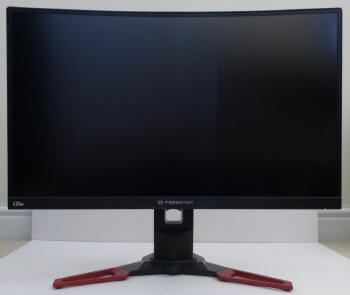
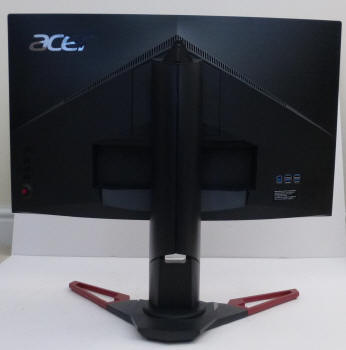
Above:
front and rear views of the screen. Click for larger versions
The bottom bezel is finished in a 'spotty'
textured plastic, which is the same on the lower part of the plastic on the back
of the screen. The rest of the back of the screen in the upper area is a black
plastic but is given a brushed aluminium style finish which looks nice. You will
note the USB hub on the back of the screen in the bottom right hand area. Also
the red OSD control joystick and buttons in the bottom left hand area.
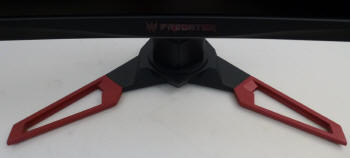
Above: view of
the base of the stand. Click for larger version
The base of the stand has some maroon coloured
aluminium sections and provides a wide, sturdy and strong base for the screen.
The supporting arm is chunky and stable also, and there is a cable tidy hole in
the arm at the bottom which is useful.
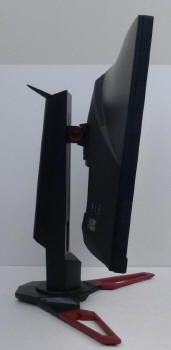
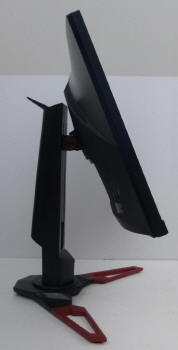
Above: full tilt
adjustment range shown. Click for larger versions
There is a decent tilt adjustment range offered
from the stand which is smooth and easy to use.
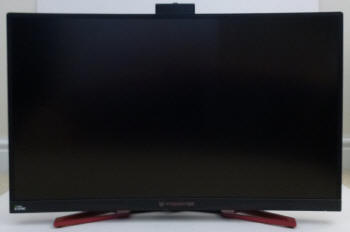

Above: full
height adjustment range shown. Click for larger versions
Height adjustment is also available with
smooth movement and a pretty easy to use mechanism. At the
lowest setting the bottom edge of the screen is ~30mm from the top of the
desk, and at maximum extension it is ~150mm. This gives a total adjustment
range of ~120mm which is decent and as advertised.
Side to side swivel is also available and is
again smooth and pretty easy to use. There is no rotation function offered
here, probably due to the curved screen format. The screen remains pretty
stable on the stand as you move it around and there's very little wobble.
A summary of the screens ergonomic adjustments
is shown below:
|
Function |
Range |
Smoothness |
Ease of Use |
|
Tilt |
Yes |
Smooth |
Easy |
|
Height |
120mm |
Smooth |
Pretty easy |
|
Swivel |
Yes |
Smooth |
Easy |
|
Rotate |
No |
- |
- |
|
Overall |
Smooth and easy movements from
available adjustments. Stable with very little wobble. |
The materials were of a good standard and the
build quality reasonable as well. It did feel a bit more chunky and basic than
some other screens but it still looked pretty nice. There was no audible noise from the screen,
even when conducting specific tests which can often identify buzzing issues.
The whole screen remained cool even during prolonged use as well which
was pleasing.
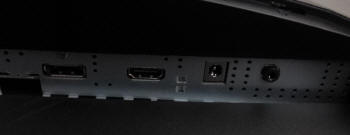
Above:
interface connections shown. Click for larger version
The back of the screen offers the interface
connections for DisplayPort and HDMI, along with the power brick connection
and a headphone jack. On the back of the screen is the USB upstream and 4x USB
3.0 downstream ports as shown below.
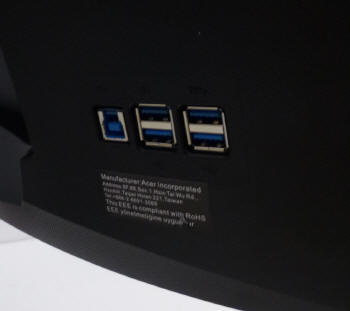
Above: USB hub
on the back of the screen. Click for larger version

OSD Menu
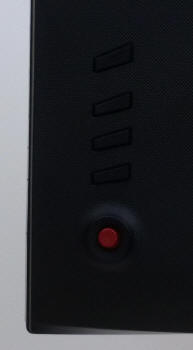
Above: OSD control joystick and control buttons on back right hand side (as
viewed from the front).
Click for larger
version
The OSD menu is controlled through 3 pressable
buttons and a joystick control on the back right hand edge of the screen . You
have to feel your way behind the screen to use these, and there is also a power
button located here at the top with a slight separation from the other buttons. We did sometimes find ourselves pressing the power button
accidentally which was a bit of a pain. The joystick is also pressable and acts
as the main control for the OSD menu.
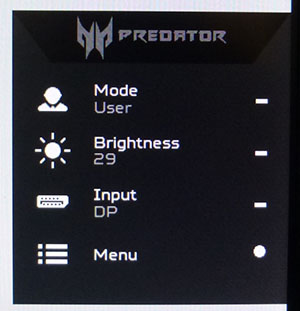
Pressing any of the buttons brings up the quick
access menu as shown above. By default there is access to the preset mode menu,
brightness control and input selection. You can customise these options via the
main menu which is useful in case you need regular access to something specific.
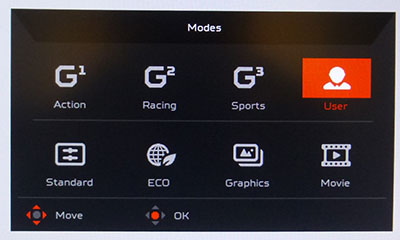
Oddly the 'modes' menu is only available if you have it selected as one of the
quick access options. It is not available in the main OSD elsewhere. Probably an
over-sight from Acer there. From the initial quick access menu, pressing the joystick
button in brings up the main OSD menu.
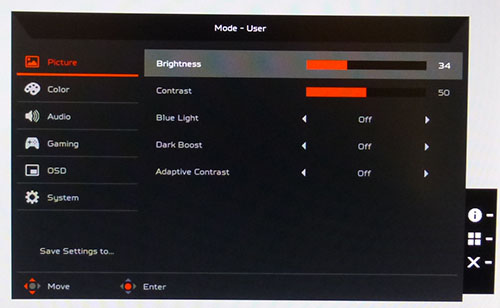
This main menu is split in to 6 sections down the
left hand side, with the options available in each then shown on the right hand
side. The 'picture' section has all the usual controls for brightness, contrast
etc. You can also use the blue light modes here if you want, or the 'dark boost'
feature for gaming.
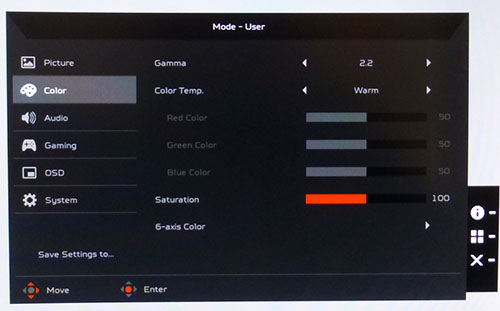
The 'color' section has controls for the gamma,
colour temp and RGB channels which will be useful for
calibration.
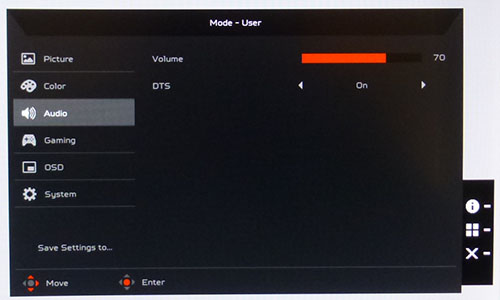
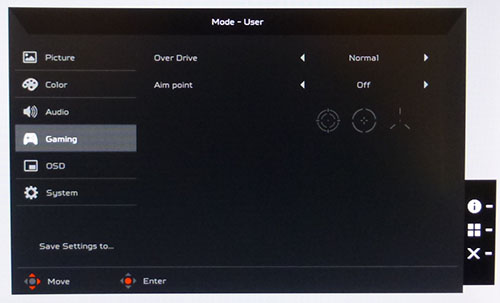
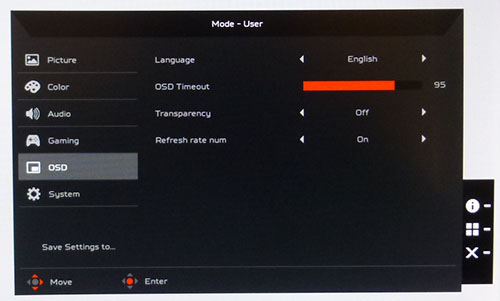
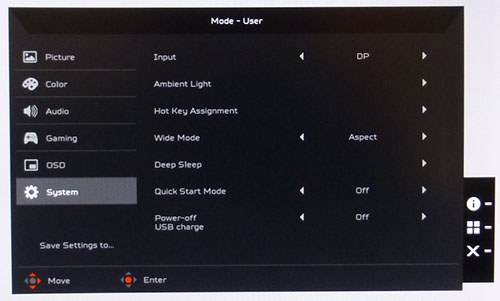
The other sections are pretty self-explanatory
from the above images. In the 'system' menu you can control the ambient light
feature as well:
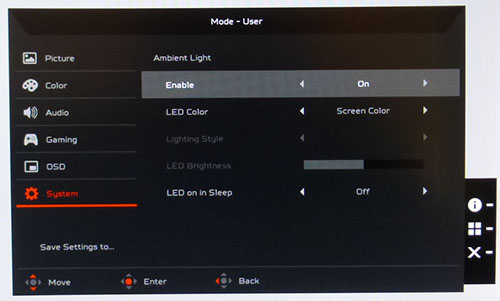
This feature provides a nice projected light from
the bottom edge of the screen which can be customised in terms of colour and
behaviour. There's even an option to match the light colour to the colour of the
content on the screen, a little like Philips AmbiLight function on some of their
TV's. The ambient light feature on this screen adds a nice premium extra and
looks pretty cool in use.
All in all the OSD menu offered a good range of
options and lots to play with. We felt navigation was mostly pretty easy thanks
to the joystick control, although the buttons on the back sometimes resulted in
accidental powering off of the screen. The joystick felt a little flimsy too but
overall we felt it was intuitive to use.

Power Consumption
In terms of power consumption the manufacturer
lists typical usage of 33W and 0.5W in standby. We carried out our normal tests to
establish its power consumption ourselves.
|
 |
|
State and Brightness
Setting |
Manufacturer Spec (W) |
Measured Power Usage
(W) |
|
Default (80%) |
33.0 |
34.2 |
|
Calibrated (27%) |
- |
24.0 |
|
Maximum Brightness (100%) |
- |
37.6 |
|
Minimum Brightness (0%) |
- |
19.1 |
|
Standby |
0.5 |
0.5 |
|
We tested this ourselves and found that out of the
box the screen used 34.2W at the default 80% brightness setting. Once calibrated the screen reached
24.0W consumption, and in standby it
used only 0.5W. We have plotted these results below compared with other screens
we have tested. The consumption is comparable to the other 27" sized
screens we have tested as you might expect, with some of the smaller screens
drawing less power and the larger screens drawing more (comparing the calibrated states).


Panel and Backlighting
|
Panel Manufacturer |
Samsung |
Colour Palette |
16.7 million |
|
Panel Technology |
SVA |
Colour Depth |
8-bit |
|
Panel Module |
LTM270HP02 |
Colour space |
Standard gamut |
|
Backlighting Type |
W-LED |
Colour space coverage (%) |
~sRGB, ~72% NTSC |
Panel Part and Colour Depth
The Acer Predator Z271 features a
Samsung LTM270HP02 SVA (Vertical Alignment type) technology panel which is capable of producing
16.7 million colours. This is achieved through a 8-bit colour depth. The
panel part is confirmed when dismantling the screen as shown below:
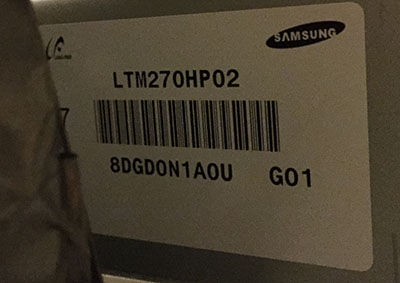
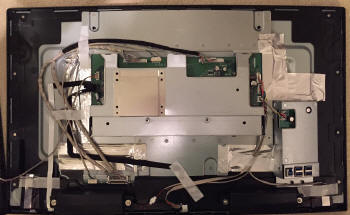
Screen
Coating
The
screen coating is a pretty light anti-glare (AG) offering. It isn't a semi-glossy
coating as some VA type panels have, but thankfully it
isn't a heavily grainy coating like some old IPS panels feature. It is also
lighter than modern TN Film 'medium' panel coating. It retains its anti-glare properties
to avoid too many unwanted reflections of a full glossy coating, but does not
produce an too grainy or dirty an image that some thicker AG coatings can.
Backlight Type and Colour Gamut
The screen uses a White-LED (W-LED) backlight unit
which is standard in today's market. This helps reduce power consumption
compared with older CCFL backlight units and brings about some environmental
benefits as well. The W-LED unit offers a standard colour gamut which is
approximately equal to the sRGB colour space. Acer quote 100% sRGB coverage in their
spec. Anyone wanting to work with wider colour spaces would need to consider
wide gamut CCFL screens or the newer range of GB-r-LED type (and similar)
displays available now. If you want to read more about colour spaces and gamut
then please have a read of our
detailed article.
Backlight
Dimming and Flicker
We tested the screen to establish the methods used
to control backlight dimming. Our in depth article talks in more details about a
common method used for this which is called
Pulse Width Modulation (PWM). This in itself gives cause for concern to some
users who have experienced eye strain, headaches and other symptoms as a result
of the flickering backlight caused by this technology. We use a photosensor +
oscilloscope system to measure backlight dimming control
with a high level of accuracy and ease. These tests allow us to establish
1) Whether PWM is being used to control the
backlight
2) The frequency and other characteristics at which this operates, if it is used
3) Whether a flicker may be introduced or potentially noticeable at certain
settings
If PWM is used for backlight dimming, the higher
the frequency, the less likely you are to see artefacts and flicker. The duty
cycle (the time for which the backlight is on) is also important and the shorter
the duty cycle, the more potential there is that you may see flicker. The other
factor which can influence flicker is the amplitude of the PWM, measuring the
difference in brightness output between the 'on' and 'off' states. Please
remember that not every user would notice a flicker from a backlight using PWM,
but it is something to be wary of. It is also a hard thing to quantify as it is
very subjective when talking about whether a user may or may not experience the
side effects.
100% 50%
0%



Above scale = 1
horizontal grid = 5ms
At 100% brightness a constant voltage is applied
to the backlight. As you reduce the brightness setting to dim the backlight a
Direct Current (DC) method is used, as opposed to any form of PWM. This applies
to all brightness settings from 100% down to 0%. The screen is flicker free as a
result as advertised, which is great news.
|
Pulse Width
Modulation Used |
No |
|
Cycling
Frequency |
n/a |
|
Possible
Flicker at |
|
|
100% Brightness |
No |
|
50% Brightness |
No |
|
0% Brightness |
No |

Contrast
Stability and Brightness
We wanted to see how much variance there was in
the screens contrast as we adjusted the monitor setting for brightness.
In theory, brightness and contrast are two independent parameters, and good
contrast is a requirement regardless of the brightness adjustment.
Unfortunately, such is not always the case in practice. We recorded the
screens luminance and black depth at various OSD brightness settings, and
calculated the contrast ratio from there. Graphics card settings were left at
default with no ICC profile or calibration active. Tests were made using an
X-rite i1 Display Pro colorimeter. It should be noted that we used the
BasICColor calibration software here to record these, and so luminance at
default settings may vary a little from the LaCie Blue Eye Pro report.
|
OSD
Brightness |
Luminance
(cd/m2) |
Black
Point (cd/m2) |
Contrast
Ratio
( x:1) |
|
100 |
338.84 |
0.11 |
3080 |
|
90 |
311.97 |
0.10 |
3120 |
|
80 |
286.43 |
0.10 |
2864 |
|
70 |
256.63 |
0.09 |
2851 |
|
60 |
227.93 |
0.08 |
2849 |
|
50 |
197.58 |
0.07 |
2823 |
|
40 |
166.72 |
0.06 |
2779 |
|
30 |
134.01 |
0.05 |
2680 |
|
20 |
100.62 |
0.03 |
3354 |
|
10 |
65.22 |
0.02 |
3261 |
|
0 |
29.15 |
<0.02 |
- |
|
Total Luminance Adjustment Range
(cd/m2) |
309.69 |
Brightness OSD setting controls backlight? |
 |
|
Total Black Point
Adjustment Range (cd/m2) |
>0.09 |
|
Average Static Contrast Ratio |
2966:1 |
PWM Free? |
 |
|
Recommended OSD setting
for 120 cd/m2 |
26 |
We conducted these tests in the default 'standard'
preset mode. The brightness control gave us a very good range of
adjustment. At the top end the maximum luminance reached 339
cd/m2 which was
a little higher even than the specified maximum brightness of 300 cd/m2
from the manufacturer. There was a decent 310 cd/m2 adjustment range
in total, and so at the minimum setting you could reach down to a nice low
luminance of 29 cd/m2. This should be adequate for those wanting to
work in darkened room conditions with low ambient light. A setting of 26 in the OSD menu should return you a
luminance of around 120 cd/m2 at default settings in this preset mode.
It should be noted that the
brightness regulation is controlled without the need for
Pulse Width Modulation, using a Direct Current (DC) method for all
brightness settings between 100 and 0% and so the screen is flicker free.

We have plotted the
luminance trend on the graph above. The screen behaves as it should in this
regard, with a reduction in the luminance output of the screen controlled by the
reduction in the OSD brightness setting. This is a linear relationship as you
can see.
The average contrast ratio of
the screen was excellent at 2966:1. This was basically on par with the Samsung
panel spec of 3000:1 and certainly a strong point of this VA technology. We have
not provided the usual contrast stability graph, as at these kind of black
depths the rounding errors introduce too much variance.

Testing
Methodology
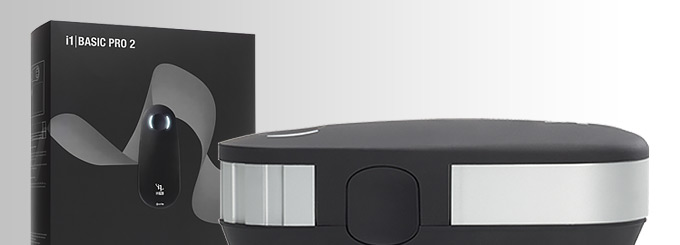
An
important thing to consider for most users is how a screen will perform out of
the box and with some basic manual adjustments. Since most users won't have
access to hardware colorimeter tools, it is important to understand how the
screen is going to perform in terms of colour accuracy for the average user.
We restored our graphics card to default settings
and disabled any previously active ICC profiles and gamma corrections. The
screen was tested at default factory settings using an
X-rite i1
Pro 2 Spectrophotometer combined with
LaCie's Blue Eye Pro software suite. An X-rite i1 Display Pro colorimeter was
also used to verify the black point and contrast ratio since the i1 Pro 2
spectrophotometer is less
reliable at the darker end.
Targets for these tests are as follows:
-
CIE Diagram - validates the colour space
covered by the monitors backlighting in a 2D view, with the black triangle representing the
displays gamut, and other reference colour spaces shown for comparison
-
Gamma - we aim for 2.2 which is the default
for computer monitors
-
Colour temperature / white point - we aim
for 6500k which is the temperature of daylight
-
Luminance - we aim for 120
cd/m2, which is
the recommended luminance for LCD monitors in normal lighting conditions
-
Black depth - we aim
for as low as possible to maximise shadow detail and to offer us the best
contrast ratio
-
Contrast ratio - we aim
for as high as possible. Any dynamic contrast ratio controls are turned off here
if present
-
dE average / maximum -
as low as possible.
If DeltaE >3, the color displayed is significantly different from the
theoretical one, meaning that the difference will be perceptible to the
viewer.
If DeltaE <2, LaCie considers the calibration a success; there remains a
slight difference, but it is barely undetectable.
If DeltaE < 1, the color fidelity is excellent.

Default Performance and
Setup
Default settings of the screen were as follows:
|
Monitor OSD Option |
Default Settings |
|
Preset mode |
Standard |
|
Brightness |
80 |
|
Contrast |
50 |
|
Gamma |
2.2 |
|
Color Temp |
Warm |
|
RGB |
50, 50, 50 (locked) |

Acer Predator Z271 - Default Settings
 



|
|
Default Settings |
|
luminance (cd/m2) |
294 |
|
Black Point (cd/m2) |
0.10 |
|
Contrast Ratio |
2864:1 |
Initially out of the box the screen was set in the
default 'standard' preset mode. With the brightness set at a high 80% level,
and so out of the
box the screen was overly bright and uncomfortable to use. You will
definitely need to turn that down to something lower for prolonged use. You could tell the screen was using a
standard gamut backlight as well with the naked eye, and the colour balance and
temperature felt good.
We went
ahead and measured the default state with the i1 Pro 2. The
CIE diagram on the left of the image confirms that the monitors colour gamut
(black triangle) is fairly equal to
the sRGB colour space. There is some minor over-coverage in greens and blues,
but not by anything significant.
Default gamma was recorded at 2.1 average, leaving it with a minor 3% deviance
from the target which was good news as gamma can be tricky to correct without a calibration device. White
point was measured at a reasonably accurate 6275k, being 3% out from the 6500k
we'd ideally want for desktop use.
Luminance was recorded at a very bright 294
cd/m2 which is
too high for prolonged general use. The screen was set at a default
80% brightness in the OSD menu but that is easy to change of course to reach a
more comfortable setting without impacting any other aspect of the setup. The
black depth was an impressive 0.10 cd/m2 at this default
brightness setting, giving us a very strong static contrast ratio of
2864:1.
Colour accuracy was also good out of the box
with an average dE of 1.8. Testing the screen with colour
gradients showed smooth transitions in all shades, with some gradation evident
in the very dark tones. Overall this default setup was good and we were
pleased with the results.

Calibration
We used the
X-rite i1 Pro 2
Spectrophotometer combined with the LaCie Blue Eye Pro software package to
achieve these results and reports. An X-rite i1 Display Pro colorimeter was used
to validate the black depth and contrast ratios due to lower end limitations of
the i1 Pro device.
|
Monitor OSD Option |
Calibrated Settings |
|
Preset Picture Adjust mode |
User |
|
Brightness |
27 |
|
Contrast |
50 |
|
RGB |
42, 48, 48 |
|
Gamma |
2.2 |
|
Colour Temp |
User |

Acer Predator Z271 - Calibrated Settings


|
|
Calibrated Settings |
|
luminance (cd/m2) |
120 |
|
Black Point (cd/m2) |
0.047 |
|
Contrast Ratio |
2529:1 |
When you start changing the brightness control or
RGB levels, you automatically move in to the 'user' preset mode. We adjusted the RGB
channels and brightness setting as shown in the table above. All these OSD
changes allowed us to obtain an optimal hardware starting point and setup before software level changes would be
made at the graphics card level. We left the LaCie software to calibrate
to "max" brightness which would just retain the luminance of whatever brightness
we'd set the screen to, and would not in any way try and alter the luminance at
the graphics card level, which can reduce contrast ratio. These adjustments
before profiling the screen would help preserve tonal values and limit
banding issues. After this we let the software carry out the LUT adjustments and create an
ICC profile.
Average gamma was now corrected to 2.2 average
with a 0% deviance, correcting the small 3% deviance we'd seen out of the box. The
white point had now been corrected to 6524k, which again corrected the small 3%
deviance we'd seen out of the box. Luminance had been improved thanks to the
adjustment to the brightness control and was now being measured at 120
cd/m2. This
left us a black depth of 0.047 cd/m2 and maintained a very strong static
contrast ratio of
2529:1. This had dropped slightly due to the reduction in the RGB settings. Colour accuracy of the resulting
profile was excellent on the most part, with dE average of 0.8 and maximum of
2.5 where red shades seemed to be a little tricky to correct. LaCie would
consider colour fidelity to be very good overall.
Testing the screen with various colour gradients
showed smooth transitions. There was some gradation in darker tones
and some very slight banding introduced in the very dark end due to the adjustments to the
graphics card LUT from the profilation of the screen.
You can use our settings and
try our calibrated ICC profile if you wish, which are available in
our ICC profile database. Keep in mind that results will vary from one
screen to another and from one computer / graphics card to another.

Calibration Performance Comparisons

The comparisons made in this section try to give
you a better view of how each screen performs, particularly out of the box which
is what is going to matter to most consumers. When comparing the default factory
settings for each monitor it is important to take into account several
measurement areas - gamma, white point and colour accuracy. There's no point
having a low dE colour accuracy figure if the gamma curve is way off for
instance. A good factory calibration requires all 3 to be well set up. We have
deliberately not included luminance in this comparison since this is normally
far too high by default on every screen. However, that is very easily controlled
through the brightness setting (on most screens) and should not impact the other
areas being measured anyway. It is easy enough to obtain a suitable luminance
for your working conditions and individual preferences, but a reliable factory
setup in gamma, white point and colour accuracy is important and not as easy to
change accurately without a calibration tool.
From these comparisons we can also compare the
calibrated colour accuracy, black depth and contrast ratio. After a calibration
the gamma, white point and luminance should all be at their desired targets.

Default setup of the screen out of the box was
good overall, with a small deviance only in the gamma curve and white point (3%
on each). The screen offered a low dE and strong static contrast ratio and should be
fine for most normal users without the need for calibration equipment. It was a
bit more accurate than many of the other 27" sized screens we've tested, which
sometimes were set up more specifically for gaming and therefore showed a much
lower gamma (e.g. Acer XG270HU = 1.8 gamma average).


The display was very strong when it came to black
depth and contrast ratio thanks to the use of a VA panel from Samsung. With a
calibrated contrast ratio of 2529:1 it easily surpassed the wide range of TN
Film and IPS-type panels which dominate the 27" market, which can reach up to
around 1000:1 to 1100:1 or so in the best cases.
|
Check Pricing and Buy - Affiliate Links
|
|
Amazon
|
|
TFTCentral is a participant
in the Amazon Services LLC Associates Programme, an affiliate
advertising programme designed to provide a means for sites to earn
advertising fees by advertising and linking to Amazon.com, Amazon.co.uk,
Amazon.de, Amazon.ca and other Amazon stores worldwide. We also
participate in a similar scheme for Overclockers.co.uk. |

Viewing Angles

Above: Viewing
angles shown from front and side, and from above and below. Click for
larger image
Viewing angles of the screen were fairly typical
for a VA technology panel. The image became more washed out as you viewed it
from a wide angle horizontally, and certainly vertical shifts were even more
noticeable with some yellowy colour tone shift evident. The viewing angles
were not as good as you will get from an IPS-type panel, but they are better
than you will see from TN Film matrices. Somewhere in the middle is VA. The
viewing angles here were a bit better than the recent
Acer Predator Z35 which showed more washed out colours from off-centre
angles.
Users should also be aware that the panel exhibits
the off-centre contrast shift which is inherent to the VA pixel structure. When
viewing a very dark grey font for example on a black background, the font
disappears when viewed head on, but gets lighter as you move slightly to the
side. This is an extreme case of course as this is a very dark grey tone we are
testing with. Lighter greys and other colours will appear a little darker from
head on than they will from a side angle, but you may well find you lose some
detail as a result. This can be particularly problematic in dark images and
where grey tone is important. It is this issue that has led to many graphics
professionals and colour enthusiasts choosing IPS panels instead, and the
manufacturers have been quick to incorporate this alternative panel technology
in their screens. We would like to make a point that for many people this won't
be an issue at all, and many may not even notice it. Remember, many people are
perfectly happy with their TN Film panels and other VA based screens. Just
something to be wary of if you are affected by this issue or are doing colour
critical work.
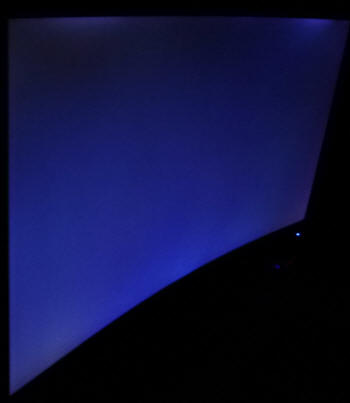
Above: View of an
all black screen from the side. Click for larger version
We captured a photo of an all-black image as
viewed from a side angle as shown above. This can help exhibit any glow you
might see on different panel technologies. On the Z271 the screen showed a
pale blue glow from an angle, which was more noticeable than on some other
modern VA panels we've tested. It was not as noticeable as a typical IPS panel
where the pale white glow can be a problem to some users.

Panel Uniformity
We wanted to test
here how uniform the brightness was across the screen, as well as identify any
leakage from the backlight in dark lighting conditions. Measurements of the
luminance were taken at 36 points across the panel on a pure white background.
The measurements for luminance were taken using BasICColor's calibration
software package, combined with an X-rite i1 Display Pro colorimeter with a
central point on the screen calibrated to 120 cd/m2. The below
uniformity diagram shows the difference, as a percentage, between the
measurement recorded at each point on the screen, as compared with the central
reference point.
It is worth
noting that panel uniformity can vary from one screen to another, and can depend
on manufacturing lines, screen transport and other local factors. This is only a
guide of the uniformity of the sample screen we have for review.

Uniformity of Luminance

The luminance uniformity of the screen was
moderate overall. There was a drop in
luminance towards the sides of the screen where in the worst case the
luminance dropped to 91
cd/m2
(-24%). That was the most extreme example though and in fact 68% of the
screen was within a 10% deviance from the centrally calibrated point which
was not too bad.

Backlight Leakage
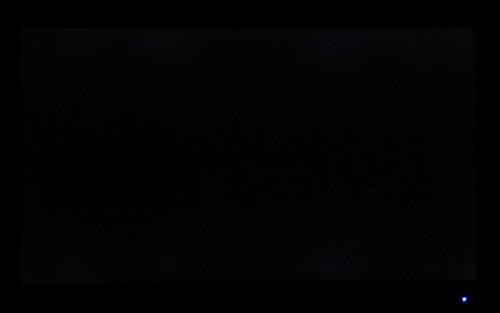
Above: All black screen in a darkened room. Click for larger version
We also tested the screen with an all black image
and in a darkened room. A camera was used to capture the result. The camera
showed there was no major backlight bleed evident, but a some slight clouding
evident from the upper corners, and a little more noticeable clouding along the
bottom edge of the screen.
Note: if you want to test your own screen for
backlight bleed and uniformity problems at any point you need to ensure you have
suitable testing conditions. Set the monitor to a sensible day to day brightness
level, preferably as close to 120
cd/m2 as you can get it (our tests are
once the screen is calibrated to this luminance). Don't just take a photo at the
default brightness which is almost always far too high and not a realistic usage
condition. You need to take the photo from about 1.5 - 2m back to avoid
capturing viewing angle characteristics, especially on IPS-type panels where
off-angle glow can come in to play easily. Photos should be taken in a darkened
room at a shutter speed which captures what you see reliably and doesn't
over-expose the image. A shutter speed of 1/8 second will probably be suitable
for this.

General and Office Applications
The Z271 has somewhat of a limited resolution for
day to day use and office work, on a screen this size. 27" panels usually offer
a nice 2560 x 1440 resolution nowadays, but the Z271 sticks with a lower 1920 x
1080 resolution. This is a limitation of the current VA panel available from
Samsung which is only produced as 1920 x 1080 @ 144Hz currently. This resolution
is more widely achievable at high refresh rates than if this was a 2560 x 1440
panel, so from a gaming point of view it is arguably more suitable in some ways.
However, the comparatively low resolution does become noticeable for general
office type work and feels a significant step down from the 1440p models we are
used to testing. With a 0.3113mm pixel pitch, fonts look quite large and less
sharp than on higher resolution panels. It is probably easier on the eye if you
have the screen positioned at a fairly long viewing distance, or if you have
weaker eye sight, but we do prefer 1440p models for this type of work by some
way. The curved format does add a bit of comfort to the usability of the screen
we felt, and the VA panel offered a decent rounded performance for these types
of use.
The light AG coating of the panel is
welcome and the
pretty
wide viewing angles provided by this panel technology helps minimize on-screen colour shift when viewed from
different angles. They are not as wide as on IPS panels so you need to be aware
of that, although the image appears more stable than on TN Film panels where
contrast and colour tone shifts are more problematic. The off-centre contrast
shift of the VA pixel alignment is annoying in some situations and may be
problematic for photo work, so something you
need to be aware of as with any other VA panel. The default
factory setup of the screen was good, offering a pretty accurate gamma curve
and white point,
excellent static contrast ratio and low dE.
The brightness
range of the screen was also very good, with the ability to offer a luminance
between 339 and 29 cd/m2. This should mean the screen is perfectly
useable in a wide variety of ambient light conditions, including darkened rooms.
A setting of ~26 in the OSD brightness control should return you a luminance
close to 120 cd/m2 out of the box. On another positive note, the brightness regulation is controlled
without the need for the use of the now infamous
Pulse-Width Modulation (PWM), and so those who suffer from eye fatigue or
headaches associated with flickering backlights need not worry.
There was no audible noise or buzzing from the screen, even when specifically
looking for it using test images with a large amount of text at once. The screen
also remains cool even during prolonged use.
There are a few extras provided here as well
including a 4x port USB 3.0 hub on the back, two with charging support. There is an audio output for headphone connection if you want, with
the display also offering 2x 7W stereo speakers. The ambient light system
provides an attractive lighting option for darker environments as well which
some people will like. There
were no further extras such as ambient light sensors or card readers on this
model which can be useful in office environments.
There was a good range of ergonomic adjustments available from the stand
allowing you to obtain a comfortable position for a wide variety of angles of
tilt, swivel and height adjustments. The VESA mounting support may also be useful to some people as well.

Above: photo of
text at 1920 x 1080 (top) and 1600 x 900 (bottom)
The screen is designed to run at its native
resolution of 1920 x 1080 and at a 144Hz recommended refresh rate. However, if
you want you are able to run the screen outside of this resolution. We tested
the screen at a lower 1600 x 900 resolution to see how the screen handles the
interpolation of the resolution, while maintaining the same aspect ratio of
16:9. At native resolution the text was sharp and clear although quite large on
a screen this size as we already mentioned. When running at a the lower
resolution the text shows moderate to high levels of blurring. You also lose a
lot of screen real-estate as well of course when running at lower resolutions.

Responsiveness and Gaming
|
Quoted G2G Response Time |
4ms G2G |
|
Quoted ISO Response Time |
n/a |
|
Panel Manufacturer and
Technology |
Samsung SVA (VA-type) |
|
Panel Part |
LTM270HP02 |
|
Overdrive Used |
Yes |
|
Overdrive Control Available to
User |
Over Drive |
|
Overdrive Settings |
Off, Normal, Extreme |
The Z271 is rated by Acer as having a 4ms G2G
response time which indicate the panel uses
overdrive /
response time compensation (RTC) technology to boost pixel transitions
across grey to grey changes. The
part
being used is the
Samsung LTM270HP02 SVA (VA-type) technology panel. Have a read about response time in
our
specs section if you need additional information about this measurement.
We will first test the screen using our thorough
response time testing method. This uses an oscilloscope and photosensor to
measure the pixel response times across a series of different transitions, in
the full range from 0 (black) to 255 (white). This will give us a realistic view
of how the monitor performs in real life, as opposed to being reliant only on a
manufacturers spec. We can work out the response times for changing between many
different shades, calculate the maximum, minimum and average grey
to grey (G2G) response times, and provide an evaluation of any overshoot present
on the monitor.
We use an
ETC M526
oscilloscope for these measurements along with a custom photosensor device.
Have a read of
our response time measurement article for a full explanation of the testing methodology and reported
data.

Over Drive Setting
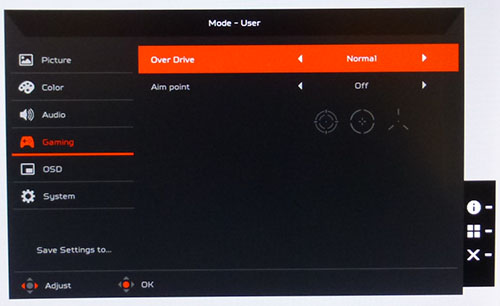
The 'Over Drive' setting is available via the
'gaming' section of the OSD menu as shown above. We will test all
three modes to see which is optimal first of all. The comparison here of the
Over Drive setting is when tested at the maximum 144Hz refresh rate. We will
test the impact of the active refresh rate on response times in a moment, but
without giving too much away, the maximum 144Hz delivered optimal response times
from the panel.



In the 'off' setting the response times were slow
as you might expect from a VA panel with no overdrive. Some transitions were
very slow, especially those from black to grey (0 > x). There was no overshoot
at all in this mode of course, since the overdrive was turned off, but we
had an average G2G response time of 15.9ms which lead to a large amount of
blurring in moving content. Switching up to the 'normal' mode improved things
quite noticeably to the naked eye, with a sharper and clearer moving image, and
a nice reduction in blurring. The average G2G response time was now recorded at
8.0ms with low levels of overshoot creeping in on a couple of
transitions. Keep in mind this is quite a small sample set of measurements, so
we will take further readings in a moment. At the maximum 'extreme' setting, the response times were pushed
even lower, to 6.0 ms G2G average now, but at the cost of some ridiculously high
overshoot levels. One transition (0 > 50) even reached down to 1.1ms G2G, but
had a huge 556% overshoot! This mode should be avoided as the overshoot was
severe and very noticeable in practice in the form of dark and pale halos and
ghosting. Stick to the 'normal' mode which was optimal here.
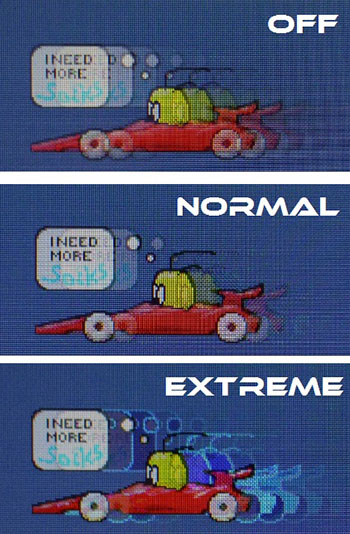
The above examples from the PixPerAn tool should
give you a further indication of the motion clarity, blurring etc seen in each
of the response time settings. You can see that the overshoot and trails in the
Extreme mode are awful!

Refresh Rate



The Z271 supports a native refresh rate of up to
144Hz, without the need for any
overclocking. We stuck with the optimal 'normal' response time setting and
then tested the pixel transition times and overshoot in a range of refresh rates
from 60Hz to 144Hz. As the refresh rate increased, the response times improved
somewhat, as it seemed that the selected refresh rate had an impact on the
overdrive control. We have seen the same thing from other G-sync screens in the
past, so this isn't a surprise. As the refresh rate is increased, the overdrive
impulse is more aggressive, helping to ensure response times are pushed lower to
meet the growing frame rate demands. At the same time, some overshoot starts to
sneak in at the highest refresh rates, where the overdrive is most aggressive,
but in this 'normal' mode it is not too bad and only at low to moderate levels.
From 100Hz and above you start to see some slight pale halos in the PixPerAn
tests for instance.
As you increase the refresh rate you not only get
this improvement in pixel response times, but you also get benefits in the way
of improved frame rate support for gaming, and also improvements in perceived
motion blur. The refresh rate of a sample-and-hold display like this has a
direct impact on perceived motion blur, so there are benefits there for the
user. The G-sync feature of the Z271 operates in a range from 30 - 144Hz, and so
as the refresh rate is dynamically controlled, so too is the overdrive impulse.
The G-sync support helps eliminate tearing in games, without the lag or
stuttering that older vsync methods introduced and is a very useful technology
as ever. Given the high refresh rate support here of 144Hz, it is useful to have
a dynamic refresh rate technology included like G-sync to support a wider range
of PC's and graphics cards with varying power.

Detailed Response Time Measurements
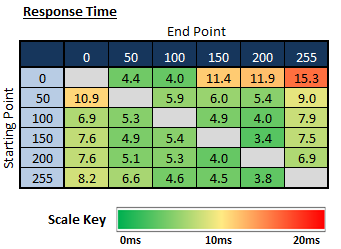 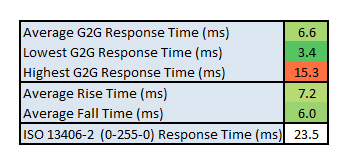
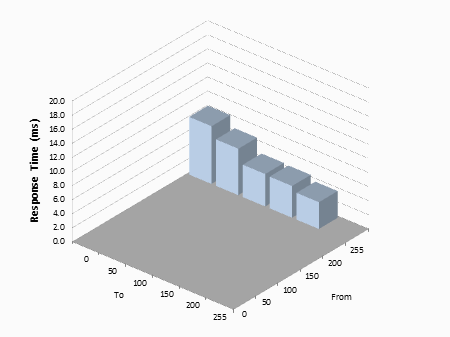
We stuck with what we consider to be the optimal 'normal'
response time setting and these measurements were taken at the maximum 144Hz
refresh rate. With this larger measurement set, the
average G2G response time was measured at 6.6ms which was actually impressive for a VA panel. Rise times (changes from dark to light shades)
were slightly slower on average than the fall times (changes from light to dark
shades) but not by much. The lowest response time measured was 3.4ms, reaching
below the
advertised 4ms G2G figure in fact. We were impressed by the pixel response times
here as VA panels are traditionally pretty slow, hence a lot of the delay with
producing high refresh rate VA panels. With a 6.6ms G2G average, the response
times are just fast enough to keep up with the frame rate demands of running at
144Hz, where a new frame is drawn every 6.94ms (1000ms / 144Hz = 6.94 ms). There
are some transitions which are slower than this threshold though and so you may
see some slight blurring added as a result in certain scenarios. You may want to
experiment with
running at 120Hz as well as 144Hz to see how each looks, or if you're using
G-sync then the refresh rate will be controlled dynamically for you anyway in
line with your frame rate.
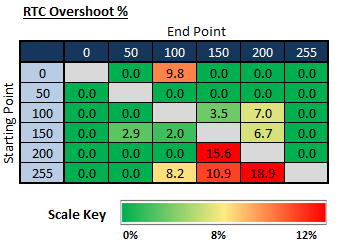
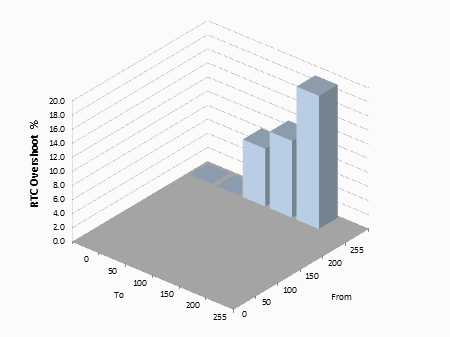
If we evaluate the Response Time Compensation
(RTC) overshoot then the results are not too bad. There is a bit of overshoot
creeping in on a few transitions, mostly changes from white to lighter grey
shades, but on the whole there was very little overshoot to be seen at all. We
know that pushing the response time setting up to the maximum 'extreme' mode
produced some crazy amounts of overshoot, so it was pleasing to see the balance
was mostly right in this 'normal' mode. As we discussed in our refresh rate section
above, the overdrive impulse is influenced by the refresh rate of the screen so
at lower refresh rates the response times will be a little slower, but the
overshoot reduces or disappears as you reach towards the lower refresh rate end.

Display Comparisons
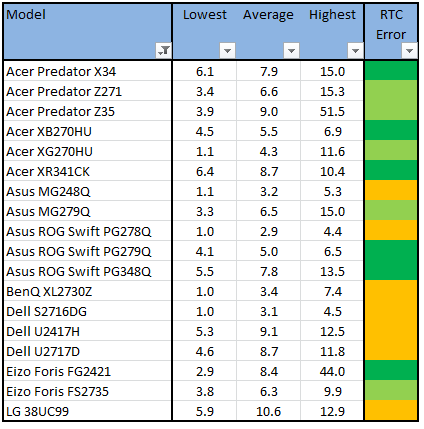
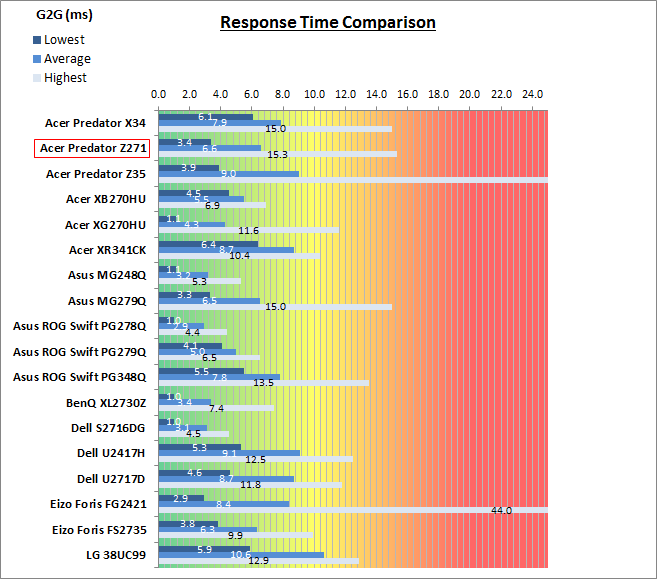
The above comparison table and graph shows you the
lowest, average and highest G2G response time measurement for each screen we
have tested with our oscilloscope system. There is also a colour coded mark next
to each screen in the table to indicate the RTC overshoot error, as the response
time figure alone doesn't tell the whole story.
The response time performance of the Z271 were
good for a VA-type panel, with a 6.6ms G2G response time measured at 144Hz. This
was just fast enough overall to keep up with the high frame rate demands, which
was good news as we've seen problems in the past where refresh rate is too high
to be practical. The
Acer Predator Z35 for instance supports up to 200Hz but only really has
response times adequate for 100 - 120Hz tops. Beyond that, blurring becomes a
real issue. The fairly low levels of overshoot on the Z271 were also good,
although you sometimes see some light halos appearing in certain situations at
the maximum refresh rate. If you're using G-sync and fluctuating between 30 -
144Hz then the overshoot only really starts to appear at all above about 100Hz.
High refresh rate 144Hz IPS-type panels
like the
Asus ROG Swift PG279Q and
Acer XB270HU can reach lower response times of around 5ms G2G which is a
little faster and smoother than the Z271 and we felt the motion clarity was a
bit better there. They were also free from any overshoot so are a bit more
suited to gaming. TN Film models with high 144Hz refresh rate like the
Asus ROG Swift PG278Q and
Dell S2716DG reach even lower at around 2.9 - 3.1ms for instance with
moderate overshoot. Don't forget that the Z271 doesn't offer any
blur reduction backlight either, like ULMB, so the motion clarity cannot
compete with those that do (when enabled).
The screen was also tested using the chase test in
PixPerAn for the following display comparisons. As a reminder, a series of
pictures are taken on the highest shutter speed and compared, with the best case
example shown on the left, and worst case example on the right. This should only
be used as a rough guide to comparative responsiveness but is handy for a
comparison between different screens and technologies as well as a means to
compare those screens we tested before the introduction of our oscilloscope
method.

27"
4ms
G2G Samsung SVA @ 144Hz (Over Drive = Normal)
In practice the Predator Z271 showed fairly low levels
of blurring on moving images with some overshoot appearing in some transitions.
There wasn't much overshoot detected in these specific colour transitions in the PixPerAn
tool, but we saw some pale halos on some test patterns elsewhere.

27"
4ms
G2G Samsung SVA @ 144Hz (Over Drive = Normal)

27"
1ms
G2G AU Optronics TN Film @ 144Hz (Response Time = Normal)

27"
1ms
G2G AU Optronics TN Film @ 144Hz (OD = Normal)

27"
4ms
G2G AU Optronics AHVA (IPS-type) @ 144Hz (OD = Normal)

27"
4ms G2G AU Optronics AHVA (IPS-type)
@ 144Hz (OD = Normal)
We can compare the Z271 to some of the other
gaming 27" models we've tested. The popular fast TN Film models like the
Dell S2716DG and
Asus ROG Swift PG278Q show smoother motion with less noticeable blur, as
their response times are faster than the VA panel of the Z271. They do show
moderate levels of overshoot though so while they feel snappier, you do have to
live with some dark trailing. The high refresh rate IPS-type panels in the
Asus ROG Swift PG279Q and
Acer Predator XB270HU are also a little faster than the Z271 and show no
overshoot, so are also a bit more suited to gaming. While the Z271's VA panel
can't quite keep up with these other high end gaming screens of other panel
technologies, it still offers a decent performance as far as VA technology goes:

27"
4ms
G2G Samsung SVA @ 144Hz (Over Drive = Normal)

35"
4ms
G2G AU Optronics AMVA @ 120Hz (OD = Normal)
We can compare the performance with another recent
high refresh rate VA panel we've tested. An AU Optronics panel with a native
144Hz refresh rate, overclocked to 200Hz in fact by Acer in their
Predator Z35. That model showed slower overall response times, including
some very slow transitions from black to grey, and struggled with refresh rates
above 120Hz in practice. The Samsung VA panel used here in the Z271 is certainly
a good step in the right direction and could keep up with the 144Hz refresh rate
demands without much problem, and showed faster and sharper moving images than
the Z35 had.

Additional Gaming Features
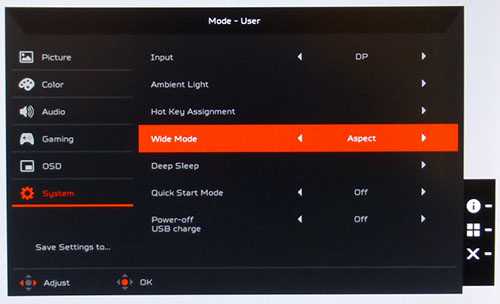
Aspect Ratio Control -
the Z271 has 2 options for
aspect ratio control through the OSD 'system' menu as shown above. There are
options for 'aspect' and '1:1' only, but that should cover most real scenarios.
The screen is natively 16:9 so will be well suited to a lot of external devices,
games consoles and DVD players anyway. The other modes will allow you to support
other unusual aspect ratios like 5:4 or 4:3 without issue.
Preset Modes -
There are three specific game preset modes
available from the 'modes' menu. There are modes for Action, Racing and Sports
to choose from. All have differing preset values but you can also save your own
settings in to each mode if you want, to set up the screen how you like for
different gaming needs. You'll
probably at least want to turn down the Over Drive setting which is set as
"extreme" in some cases!
Refresh rate num -
You can enable a setting if you want which will display your active refresh rate
in the top corner of the screen.
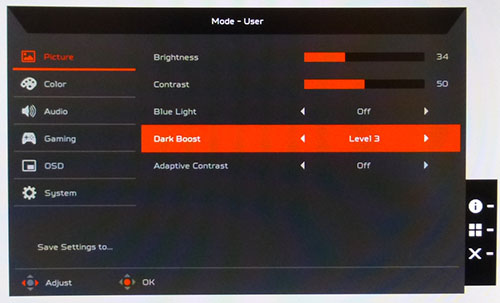
Dark Boost
- You can adjust this slider to change the black saturation levels in dark
images, to help bring out detail in darker scenes. Might be useful if you play a
lot of darker games although the black depth and contrast ratio is also a strong
point of this VA panel.

Lag
We have written an in depth article about
input lag and the various measurement techniques which are used to evaluate
this aspect of a display. It's important to first of all understand the
different methods available and also what this lag means to you as an end-user.
Input Lag vs. Display Lag vs. Signal
Processing
To avoid confusion with different terminology we
will refer to this section of our reviews as just "lag" from now on, as there
are a few different aspects to consider, and different interpretations of the
term "input lag". We will consider the following points here as much as
possible. The overall "display lag" is the first, that being the delay between
the image being shown on the TFT display and that being shown on a CRT. This is
what many people will know as input lag and originally was the measure made to
explain why the image is a little behind when using a CRT. The older stopwatch
based methods were the common way to measure this in the past, but through
advanced studies have been shown to be quite inaccurate. As a result, more
advanced tools like SMTT provide a method to measure that delay between a TFT
and CRT while removing the inaccuracies of older stopwatch methods.
In reality that lag / delay is caused by a
combination of two things - the signal processing delay caused by the TFT
electronics / scaler, and the response time of the pixels themselves. Most
"input lag" measurements over the years have always been based on the overall
display lag (signal processing + response time) and indeed the SMTT tool is
based on this visual difference between a CRT and TFT and so measures the
overall display lag. In practice the signal processing is the element which
gives the feel of lag to the user, and the response time of course can
impact blurring, and overall image quality in moving scenes. As people become
more aware of lag as a possible issue, we are of course keen to try and
understand the split between the two as much as possible to give a complete
picture.
The signal processing element within that is quite
hard to identify without extremely high end equipment and very complicated
methods. In fact the studies by Thomas Thiemann which really kicked this whole
thing off were based on equipment worth >100,1000 Euro, requiring extremely high
bandwidths and very complicated methods to trigger the correct behaviour and
accurately measure the signal processing on its own. Other techniques which are
being used since are not conducted by Thomas (he is a freelance writer) or based
on this equipment or technique, and may also be subject to other errors or
inaccuracies based on our conversations with him since. It's very hard as a
result to produce a technique which will measure just the signal processing on
its own unfortunately. Many measurement techniques are also not explained and so
it is important to try and get a picture from various sources if possible to
make an informed judgement about a display overall.
For our tests we will continue to use the SMTT
tool to measure the overall "display lag". From there we can use our
oscilloscope system to measure the response time across a wide range of grey to
grey (G2G) transitions as recorded in our
response time
tests. Since SMTT will not include the full response time within its
measurements, after speaking with Thomas further about the situation we will
subtract half of the average G2G response time from the total display lag. This should allow us to give a good estimation of
how much of the overall lag is attributable to the signal processing element on
its own.
Lag Classification
To help in this section we will also introduce a broader classification system
for these results to help categorise each screen as one of the following levels:
-
Class 1)
Less than 16ms / 1 frame lag - should be fine for gamers, even at high levels
-
Class
2)
A lag of 16 -
32ms / One to two frames - moderate lag but should be fine for many gamers.
Caution advised for serious gaming and FPS
-
Class
3)
A lag of more
than 32ms / more than 2 frames - Some noticeable lag in daily usage, not
suitable for high end gaming

For the full reviews of the models compared here and the dates they were written
(and when screens were approximately released to the market), please see our
full
reviews index.
|
(Measurements in ms) |
|
|
Total Display Lag (SMTT
2) |
6.71 |
|
Pixel Response Time
Element |
3.30 |
|
Estimated Signal
Processing Lag |
3.41 |
|
Lag Classification |
1 |
|

Class
1 |
We have provided a comparison above against other
models we have tested to give an indication between screens. The screens
tested are split into two measurements which are
based on our overall display lag tests (using SMTT) and half the average G2G
response time, as measured by the oscilloscope. The response time is split from
the overall display lag and shown on the graph as the green bar. From there, the
signal processing (red bar) can be provided as a good estimation.
The screen showed a total average display lag of
only 6.71 ms as measured with SMTT 2. Taking into account half the average G2G
response time at 3.3ms, we can estimate that there is ~3.41ms of signal
processing lag on this screen which is basically nothing. This is fairly typical
result from a G-sync screen and there are no issues here at all for gaming.

Movies and Video

The following summarises the screens performance
in video applications:
-
27"
screen size makes it a reasonable option for an all-in-one multimedia screen, but
being quite a bit smaller than most modern LCD TV's of course.
-
16:9
aspect ratio is more well suited to videos, leaving small borders on DVD's and
wide screen content at the top and bottom.
-
1920 x
1080 resolution can support full 1080 HD resolution content
-
Digital interfaces support HDCP for any encrypted and protected content
-
Fairly limited range of connectivity
options provided with only DisplayPort and 1x HDMI offered. Although at least
there is HDMI for connection of an external device if you want.
-
Cables provided in the box
for DisplayPort only.
-
Light
AG coating providing clean and clear images, without the
unwanted reflections of a glossy solution.
-
Wide
brightness range adjustment possible from the display, including a maximum
luminance of ~339
cd/m2 and a decent minimum luminance
of 29 cd/m2. This should afford you good control for different
lighting conditions. Contrast ratio remains stable across that adjustment
range as well and is excellent thanks to the VA panel. Brightness regulation is
controlled without the need for PWM and so is flicker free for all brightness
settings.
-
Black
depth and contrast ratio are excellent thanks to the VA panel at 2529:1 after
calibration. Detail in darker scenes should still not be lost as a result.
-
There
is a specific 'movie' preset mode available for movies or video if you want
which doesn't look that dissimilar to our calibrated custom mode, other than
the brightness being at 77%. Might be useful if you want a brighter mode for
movies, but you can't change any settings without it reverting back to the
user mode again so it's fairly useless we felt.
-
Good
pixel responsiveness which should be able to handle fast moving scenes in
movies without issue. At 60Hz (which would be used certainly for external
devices) there is no overshoot in the 'normal' Over Drive mode.
-
Pretty wide viewing angles thanks to the VA panel
technology meaning several people should be able view the screen at once comfortable
and from a whole host of different angles. The viewing angles are not as wide
as IPS and you do start to see some washing out of the image if you're viewing
from too wide an angle.
-
Some pale blue glow on dark content from an
angle, but not as noticeable as typical IPS glow.
-
Good and easy to use ergonomic adjustments
available from the stand, making it easy to reposition the screen for viewing
if needed.
-
No
noticeable backlight leakage, and none from the edges which is
good. This type of leakage may prove an issue when watching movies where black
borders are present but it is not a problem here.
-
2x 7W
integrated stereo speakers on this model. There is also an audio output
connection for headphones if needed.
-
Decent
range of hardware aspect ratio options including 'aspect' and a 1:1 pixel mapping mode.
-
Picture in picture (PiP) and Picture By Picture (PbP) are not available on
this screen.

Conclusion
The Z271 delivered a lot of what we expected from
a VA panel, and actually a little more. This panel technology is characterised
by its strong contrast ratio and deep blacks, which it delivered - well beyond
the Acer 1000:1 spec in fact. A lot of people like VA panels since they are not
subject to the white glow that IPS panels are, and the viewing angle performance
of the panel here was again pretty typical for VA. Somewhere between IPS and TN
Film, but as expected. We were impressed though with the noticeable steps
forward Samsung have managed to make with VA response times. This has always
been a weak point of VA tech, but Samsung have done a nice job boosting pixel
transitions, along with the increased native refresh rate of 144Hz. It's not
quite as fast as IPS and TN Film gaming screens, but it offers a decent gaming
option in the VA space. Overshoot is minimal and the G-sync support and wide
refresh rate range helps make this well suited to a large audience and varying
system capabilities. Input lag was also very low, as we had expected given the
presence of the G-sync module. We were disappointed that ULMB wasn't included,
as there's no real reason why it couldn't be given response times were adequate
to support the refresh rate.
In other areas the default setup of the screen was
good, and it offered a nice range of easy to use stand adjustments and some nice
extras like the USB hub, speakers and ambient light system. The 1080p resolution
felt limited for day to day desktop use, having used so many high res screens in
recent times. However, some people will still be fine with this resolution and
screen size, and it's certainly less demanding on your system and graphics cards
when it comes to gaming at high refresh rates. One to be wary of. Overall we
felt this was a good outing from VA tech with some obvious improvements in
response times and gaming performance which can only be a good thing.
If you appreciate this review and enjoy reading and like our work, we would welcome a
donation
to the site to help us continue to make quality and detailed reviews for you.
|
Pros |
Cons |
|
Strong contrast ratio and
black depth thanks to VA panel |
Missing ULMB blur reduction
mode |
|
Decent response times, high
refresh rate, G-sync support and low lag make it a good VA gaming option |
1920 x 1080 resolution is
limited for general use outside of gaming on a screen this size |
|
Good default setup and overall
performance |
VA not quite as fast for
gaming as IPS and TN Film options |
|
Check Pricing and Buy - Affiliate Links
|
|
Amazon
|
|
TFTCentral is a participant
in the Amazon Services LLC Associates Programme, an affiliate
advertising programme designed to provide a means for sites to earn
advertising fees by advertising and linking to Amazon.com, Amazon.co.uk,
Amazon.de, Amazon.ca and other Amazon stores worldwide. We also
participate in a similar scheme for Overclockers.co.uk. |
|